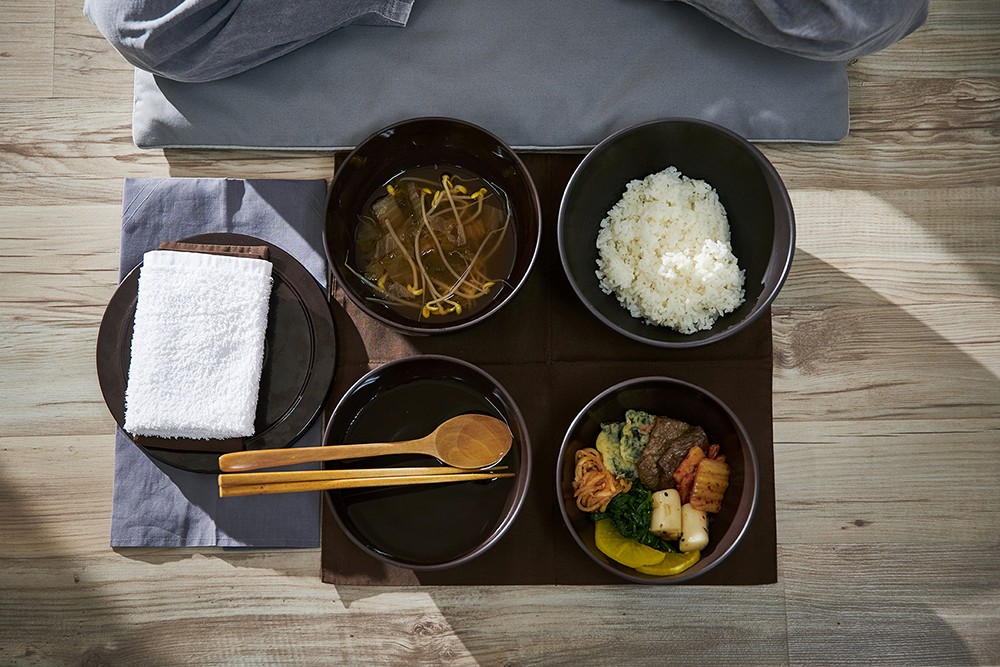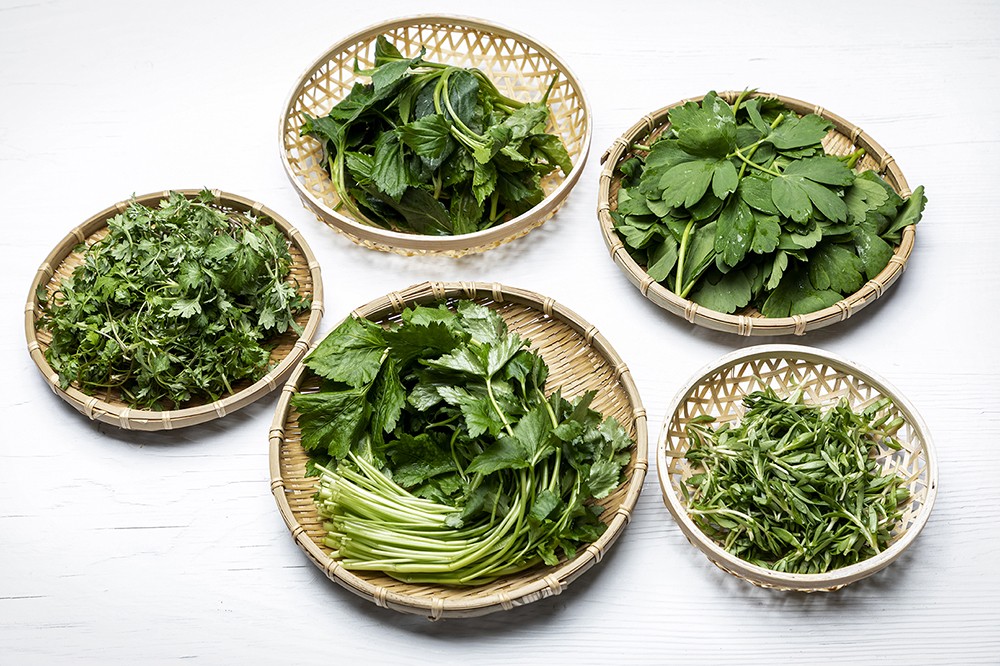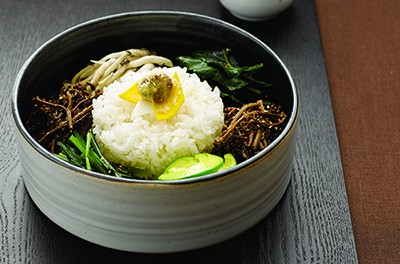한식 읽기 좋은 날
Vol 51. Korean Food that comes from trees
Temple cuisine as a precursor of vegetarian recipes
Captivated by HANSIK
Food that is eaten at Korea’s Buddhist temples is characterized—from the selection of ingredients to the cooking methods used and even how the table is set—by a beautiful simplicity that reflects elements of Buddhist thought. The recent surge of interest in vegetarianism is leading to a renewed interest in temple cuisine. Let’s explore several popular vegetarian recipes that are actually temple foods.
Article Cha Yeji (Editorial Team) Source Livestock's Long Shadow: Environmental Issues and Options

Temple food restaurants are the next popular trend
Temple food is vegetarian cuisine that, according to the Buddhist precept that forbids the taking of life, contains no meat or artificial seasonings. It is characterized by two qualities: 1) refraining from excessive eating and 2) highlighting natural flavors entirely with natural ingredients.
One aspect that differentiates Korean Buddhist temple food from conventional vegetarianism and the Buddhist temple foods of other countries is that it does not use osinchae, or the “five forbidden pungent roots”: scallions, garlic, chives, dallae (wild chives), and mureut (Chinese squill). These five vegetables are not used in any temple dishes because their distinct, strong flavors are believed to distract monks from their meditation and mental training. As a result, Korean temple food is both flavorful and easy to digest.
Recently, an uptick in interest in vegetarian eating is leading to the growing popularity of temple cuisine. Of the multiple levels of vegetarianism, the highest is veganism, which forbids all animal-derived food, including dairy products such as milk and eggs. It is this use of only vegetables—in other words, the adherence of Korean temple food to the rules of veganism—that is making temple cuisine a viable option for vegans. Indeed, temple cuisine restaurants are increasing in number not only in Seoul but throughout Korea as well.

Practicing vegetarianism through Gen MZ’s value consumption and the rise of veganism
In the past, people became vegetarians for health-related reasons: namely, because a vegetable-focused diet reduces the fat consumption and is easy to digest. The recent interest in vegetarian food among Gen MZ (which, in Korea, refers to people born between 1981 and 2010), however, is more closely aligned with a desire for “value consumption”—the growing interest in animal rights that is resulting in a refusal to consume the flesh of animals that were raised in a poor environment (cows, pigs, chickens, etc.).
Another reason people embrace vegetarianism is the environmental destruction that occurs due to the carbon emitted in the process of raising livestock. According to a report by the Food and Agriculture Organization (FAO) of the United Nations, Livestock's Long Shadow: Environmental Issues and Options, the livestock industry is responsible for 18 percent of total greenhouse gas emissions. This figure is higher than even that of the shipping/transport industry (14 percent).
Value consumption refers to “a rational method of consumption that is not swayed by advertising or brand images and is based on purchasing products according to the consumer’s value judgments.” Experts argue that Gen MZ’s advocating of ethical consumption, environmental conservation, and positive influence is dovetailing with vegetarianism to result in an increase in vegetarians and interest in Korean temple cuisine.



Temple cuisine that is popular outside of Korea
Vegetarianism was adopted much earlier overseas than in Korea. There are many academic societies and organizations on vegetarianism as well as a wealth of information on vegetarianism and vegetarian restaurants. Of the many cultural reasons for Korea’s relatively late arrival to vegetarianism, the biggest is the fact that many Korean foods are vegetable-based. In other words, there was no need to make vegetarian food a separate category because its principles already defined much of Korean cuisine. Rice, the staple food of Korea, as well as Korean side dishes (especially namul) and jeon/buchimgae are all vegetarian, which makes it quite easy to design vegetarian menu options with Korean food. Removing meat (broth, etc.) and seafood (saeujeot (salted shrimp), etc.) from the seasoning allows for even more types of vegetarian dishes.
The recent surge in the popularity of Korean cultural content overseas is leading to increased international interest in the foods that are featured in such content. Temple food is especially noted because it can be experienced through the many temple stay programs offered throughout Korea and teaches a lot about Korean table settings. This month, Hongseung Seunim of the Cultural Corps of Korean Buddhism (sponsored by the Jogye Order of Korean Buddhism) demonstrated how to make traditional Korean jang at the world-renowned Le Cordon Bleu. One of the outcomes of this demonstration is Le Cordon Bleu’s decision to adopt Korean temple food as a regular course of its Plant-Based Culinary Arts program.
As previously mentioned, Korean temple cuisine is much milder in flavor than other kinds of Korean food. This is because it does not use osinchae, which is what makes it popular with foreigners. Kimchi, the most famous Korean dish, is usually difficult for non-Koreans to eat because of its spicy seasoning. On the other hand, temple food is an easy recommendation for foreigners who are experiencing Korean food for the first time thanks to its mildness and absence of pungent odors (e.g. garlic, scallions).
Healthy foods that are beautifully set with ingredients from nature
What, then, are examples of temple foods that are easily accessible by ordinary consumers? One is sanchae bibimbap, which is made with wild mountain greens (sannamul, or “mountain namul”). In Korea, most Buddhist temples are located deep inside the mountains. The fact that most of the Korean Peninsula is mountainous led to the long-held tradition of eating wild greens found in the mountains. Namul, which is usually cooked by parboiling and then mixing with a seasoning, is frequently paired with bibimbap because the flavors complement one another well. The mixture of greens and rice may not make the most “elegant” dish, but the simplicity of its appearance is more than compensated for by its nutritional value (and, some argue, by the energy of Korea’s mountains!).
Another advantage of sanchae bibimbap is the fact that you can choose the main ingredient—not only according to what is in season at the time but also excluding anything that does not agree with the person to which it is being served. When serving sanchae bibimbap to a foreigner, one way to “lower the barrier” is to use namul that is mild in flavor and/or the diner has already experienced through other Korean foods.
Jang, which is based on the long-term fermentation of natural ingredients, occupies an important position in Korean cuisine and can be understood as similar to Western sauces. The main ingredient of all jang (doenjang (soybean paste), gochujang (red pepper paste), and ganjang (soy sauce)) is the soybean, which is rich in protein and can therefore correct the nutritional imbalance to which most vegetarian dishes are prone. (Useful tip: the capsaicin in red pepper paste is known to reduce body fat.)
Jangtteok, a rice cake that is made with a batter of red pepper paste and dough, is delicious both alone and when grilled with vegetables. It can also be made with spring namul, dureup (fatsia shoots), or the leaves of the “Korean mint” (Agastache rugose), which grows in most East Asian countries (China, Japan, Taiwan, and Korea). Korean mint leaves, which have a unique scent that pairs well with jangtteok, are especially beneficial because they are easily digested and rich in vitamins and minerals, making them a welcome addition to a food or meal that would otherwise be lacking in such nutrients.
Korea’s temple cuisine uses vegetables in diverse ways to enhance the flavor of its dishes. Combined with the rise of vegetarianism, the nature-friendly culture of Korean temple food is expected to expedite the international prominence of “Korean-style vegetarianism.”

 한국어
한국어
 English
English






